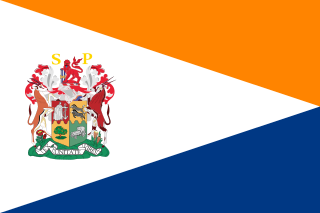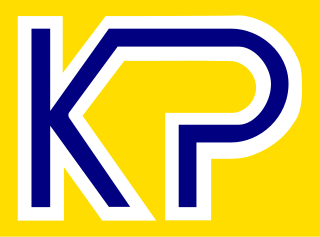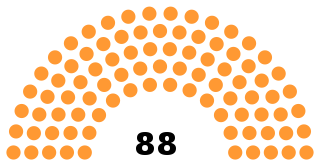Tricameralism is the practice of having three legislative or parliamentary chambers. It is contrasted with unicameralism and bicameralism, which are both far more common.

The State President of the Republic of South Africa was the head of state of South Africa from 1961 to 1994. The office was established when the country became a republic on 31 May 1961, outside the Commonwealth of Nations, and Queen Elizabeth II ceased to be Queen of South Africa. The position of Governor-General of South Africa was accordingly abolished. From 1961 to 1984, the post was largely ceremonial. After constitutional reforms enacted in 1983 and taking effect in 1984, the State President became an executive post, and its holder was both head of state and head of government.

The Parliament of the Republic of South Africa is South Africa's legislature; under the present Constitution of South Africa, the bicameral Parliament comprises a National Assembly and a National Council of Provinces. The current twenty-eighth Parliament was first convened on 14 June 2024.

Pieter Willem Botha, was a South African politician. He was the head of government of South Africa from 1978 to 1989, serving as the last prime minister of South Africa from 1978 to 1984 and the first executive state president of South Africa from 1984 to 1989.

The National Party, also known as the Nationalist Party, was a political party in South Africa from 1914 to 1997, which was responsible for the implementation of apartheid rule. The party was an Afrikaner ethnic nationalist party, which initially promoted the interests of Afrikaners but later became a stalwart promoter and enactor of white supremacy, for which it is best known. It first became the governing party of the country in 1924. It merged with its rival, the SAP, during the Great Depression, and a splinter faction became the official opposition during World War II and returned to power. With the National Party governing South Africa from 4 June 1948 until 9 May 1994, the country for the bulk of this time was only a de jure or partial democracy, as from 1958 onwards non-white people were barred from voting. In 1990, it began to style itself as simply a South African civic nationalist party, and after the fall of apartheid in 1994, attempted to become a moderate conservative one. The party's reputation was damaged irreparably by perpetrating apartheid, and it rebranded itself as the New National Party in 1997 before eventually dissolving in 2005.

The Conservative Party was a far-right South African political party that sought to preserve many aspects of apartheid in the system's final decade, and formed the official opposition in the white-only House of Assembly in the last seven years of minority rule. It declined quickly after apartheid ended, before being merged with the Freedom Front in 2004.
The Cabinet of South Africa is the most senior level of the executive branch of the Government of South Africa. It is made up of the president, the deputy president, and the ministers.
The Senate was the upper house of the Parliament of South Africa between 1910 and its abolition from 1 January 1981, and between 1994 and 1997.
General elections were held in South Africa on 22 April 1970 to elect members of the 166-seat House of Assembly. Parliament was dissolved on 2 March and the deadline for the submission of candidates was 13 March.

General elections were held in South Africa on 29 April 1981. The National Party, under the leadership of P. W. Botha since 1978, lost some support, but achieved another landslide victory, winning 131 of 165 directly elected seats in the House of Assembly.
General elections were held in South Africa in August 1984 to elect Coloured and Indian representatives to their respective houses of the Tricameral Parliament. The Coloured elections for the House of Representatives took place on 22 August, and resulted in a victory for the Labour Party, headed by the Reverend Allan Hendrickse, which won 76 of the 80 seats. The Indian elections for the House of Delegates were held on 28 August and saw the National People's Party emerge as the largest party, winning 18 of the 40 seats. The Indian elections were opposed by the United Democratic Front and were marked by boycotts and protests. Despite the Prohibition of Political Interference Act of 1968 which banned mixed-race political parties, nine Indian members of Hendricke's Labour Party stood as independents, one of whom won a seat and subsequently joined the NPP.

A referendum on a new constitution was held in South Africa on 2 November 1983 in which the white population was given the opportunity to approve or reject the Constitution of 1983. This constitution introduced the Tricameral Parliament, in which Coloured and Indian South Africans would be represented in separate parliamentary chambers, while black Africans, who were the majority of South Africa's population, would remain unrepresented. The referendum passed with 66.3% of voters voting "Yes"; consequently the new constitution came into force on 3 September 1984.

The New Republic Party (NRP) was a South African political party. It was formed as the successor to the disbanded United Party (UP) in 1977 and as a merger with the smaller Democratic Party. It drew its support mainly from the then Province of Natal, and tried to strike a moderate course between the apartheid policy of the ruling National Party (NP) and the liberal policies of the Progressive Federal Party (PFP).

The House of Assembly was the lower house of the Parliament of South Africa from 1910 to 1981, the sole parliamentary chamber between 1981 and 1984, and latterly the white representative house of the Tricameral Parliament from 1984 to 1994, when it was replaced by the current National Assembly. Throughout its history, it was exclusively constituted of white members who were elected to office predominantly by white citizens, though until 1960 and 1970, respectively, some Black Africans and Coloureds in the Cape Province voted under a restricted form of suffrage.

The House of Delegates was a body in the Tricameral Parliament of South Africa which existed from 1984 to 1994. It was reserved for Indian South Africans. The body was elected twice; in 1984 and 1989. It was the second time in South Africa's history that Indians had ever had any sort of representation at the national level, the first being the South African Indian Council. It was originally to be called the Chamber of Deputies.
Jan Christiaan "Chris" Heunis, DMS was a South African Afrikaner lawyer, politician, member of the National Party and cabinet minister in the governments of John Vorster and P. W. Botha.

The 1984 South African presidential election was the first to be held under the new South African Constitution of 1983, which abolished the office of Prime Minister and merged its powers into the position of State President, who was now both head of state and government. According to the new basic law, the State President was to be elected by an electoral college composed of members of the majority party in each of the chambers of the new tricameral parliament. As such, the electoral college was composed of 50 National Party members elected by the House of Assembly, 25 Labor Party members elected by the House of Representatives, and 13 members of the National People's Party elected by from the House of Delegates.

The 1989 South African presidential election resulted in the election of Frederik Willem de Klerk as State President.
Solidarity was a political party created in the lead-up to the 1984 South African general election, which determined the makeup of the first House of Delegates, the body within the Apartheid Tricameral Parliament reserved for Indian South Africans. It took its name from the Polish trade union.p. 40 Its first leader was JN Reddy, an influential banker and businessman with a number of company directorships. To be able to lead the party, Reddy relinquished some of his business interests. Another important party member was Pat Poovalingam, the chairman of weekly newspaper "The Graphic". Solidarity appealed more to South Africans with Southern Indian roots, while Amichand Rajbansi's National People's Party appealed more to those with a North Indian heritage.
Mario George Masher was a South African politician from the Western Cape. He represented the National Party (NP) in the National Assembly from 1994 to 1999, when he defected to the African National Congress (ANC). A teacher by profession, he formerly represented the Labour Party in the Tricameral Parliament. After joining the ANC, he was appointed South African Consul-General to Hong Kong and Macau.












